An extremely rare American Civil War era
military stomach/enema pump
set; dual-function enema and stomach pump set with maker's mark "V.W.
Brinkerhoff". (a.k.a. Brinckerhoff) A lacquered brass enema pump with tapered bone or ivory
attachments and a wooden bite bar fitted in a velvet-lined mahogany case
secured with a brass
military sliding latch
like those used by the Hosp. Dept. during the War. The mahogany case is 2 3/4" x
11 3/4" x 6 1/4". The brass plate where " U.S.A Medical
Department or Hospital Department " would have been engraved is missing, but
that is not unusual as at the end of the War, this kind of surplus material was sold
to the public and the buyer may have just removed the military name plate.
The tell-tale indication this is a
military spec issue instrument is the military sliding latch instead of a key
lock. Brinkerhoff was also a known supplier to the Union military
Medical and Hospital Departments during the
Civil War. Snowden and Brother show a similar pump in their catalog
(see bottom of page) just
prior to the War. European supplied pumps are common, but one in
military configuration by an American Civil War maker and marked...rare!
It is a well known fact one of the
biggest problems the troops on both sides faced in the field was intestinal disease and sickness. This instrument would have been used for gastric lavage,
enema, and flushing out the stomach, as well as administering various drugs
via the stomach and rectum. Examples from the Medical and Surgical
History of the Rebellion of the use of this type of stomach pump during
the War are listed at the bottom of this page.
V. W. Brinkerhoff (Vanwyck Brinkerhoff, a.k.a. Brinckerhoff)
1856: 12 Gold
1857:
88 John
1858-59: 88 John and 25 Gold
1860-62: 88 William
instruments
1863-68: 131 William
fancy goods and drugs [1867 advertisement:
18
Beekman manufacture of surgical instruments, medical chests,
saddle bags, pill machines, trusses, syringes, etc., is continued as
formerly in my own new and commodious Factory. 65 and 67
Boerum St., Brooklyn, E.D.]
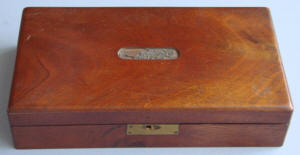
Mahogany case with military style sliding
latch, missing brass plate. (The plate size would have
been sufficient for the engraved name "U.S.A. Medical Dept.)
and the brass plate is a type typically seen on Medical Dept.
marked sets.
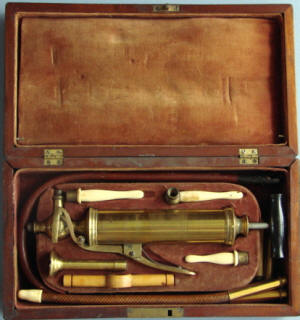
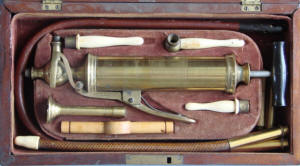
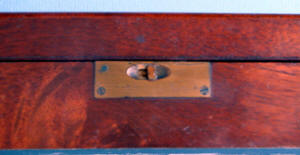
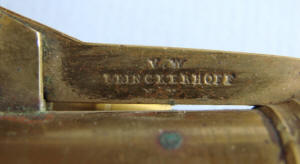
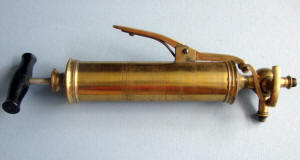
Engraved with maker name:
Brinkerhoff, who was a N.Y. contract purveyor during the
Civil War
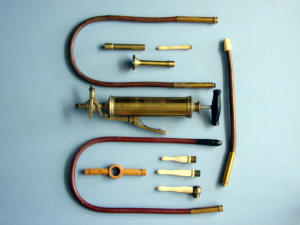
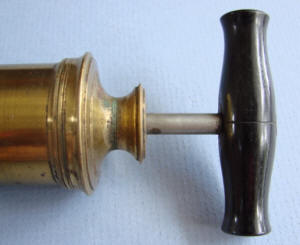
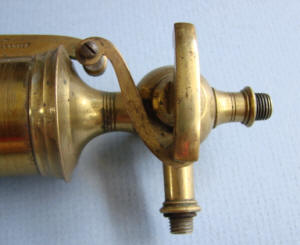
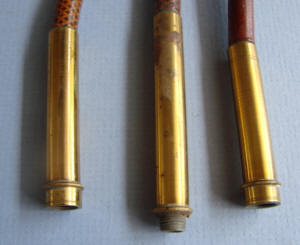
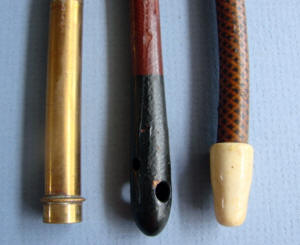

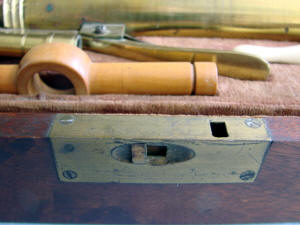
There are numerous examples of the use
of an enema or
stomach pump in
the Medical and Surgical History of the War of the Rebellion for the
treatment of dysentery, liquid diet, administer anesthetics, administration
of stimulants, food, drugs, various homeopathic medicine, and cleaning of
the bowels. The set above could have been used for all of the noted
procedures.
CASE.--Private William Semmons, Co. F, 14th New York Heavy Artillery, aged
20 years, was wounded at Petersburg, March 25th, 1865, by a fragment of
shell, which entered the right cheek, fractured the zygomatic process of the
malar bone, comminuted the ramus and body of the inferior maxilla, lacerated
and opened the ducts of the parotid and maxillary glands, and removed all
the integuments of the cheek, leaving the right angle of the mouth hanging
loose. He was taken to the field hospital of the Ninth Corps, where about,
two inches of the alveoli of the superior maxilla was excised and the wound
stitched. On April 1st, he was transferred to Armory Square Hospital,
Washington. Owing to his inability to swallow, liquid food and stimulants
were introduced by the
stomach pump.
CASE.--Private Lysander Martin, independent company, Andrew's Massachusetts
Sharpshooters, aged 28 years, was wounded at
Fredericksburg, June
10th, 1863, by a conoidal ball, which entered the neck three-fourths of an
inch under the left ear, passed through the root of the tongue, and emerged
through the middle of the right cheek. On June 14th, he was admitted to
Hammond Hospital, Maryland, suffering much from pharyngitis, difficulty of
deglutition, and very distressing dyspnoea. Cold water dressings were
applied to the wound, and liquid diet administered by means of the
stomach pump.
(**) STILLE--p. 366, op.
cit., p. 650, supra--speaking of acute dysentery in patients who are
"not of a vigorous constitution," says: "Enemata
are useful in this form of dysentery, if in any acute form, of which there
is serious doubt."
On the other hand, WARING---p.
103, op. cit., p. 696 supra--gives a formula for an
enema,
used by MCGREGOR in chronic dysentery, containing 20 grains of the nitrate
in two fluid ounces of mucilage combined with opium, HARTSUFF--loc. cit.--used
10 to 15 grains to the ounce of water.
Although there was no imperative symptom demanding an operation, yet, as the
presence of effusion was so clearly indicated by
stethoscope
and other symptoms, it was thought advisable to operate, which was done
substantially after the manner of Wyman and Bowditch, using a small
exploring trocar, but in connection with the
stomach-pump furnished army surgeons,
in place of the more complicated instrument invented especially for this
purpose.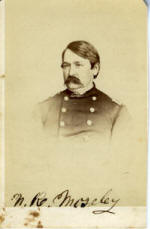
CASE
l194.--Private B. F. Brown, Co. C, 22d Massachusetts, aged 23 years, was
admitted into Finery Hospital, Washington. May 13, 1864, with gunshot wounds
of the thigh, leg, and neck, received at the battle of the Wilderness, May
7, 1864. The thigh had been amputated on the field on May 7th,
in the lower third, by lateral flaps. A ball had entered the neck below the
angle of the jaw, passed through the larynx, and lodged near where the
carotid crosses the omo-hyoid muscles. On May 16th the ball was extracted
from its position against the carotid by an incision one and a half inches
long, one inch below the mastoid process of the temporal bone, by Acting
Assistant Surgeon W. H. Ensign, U.S.A. At this date the thigh was healing
kindly by first intention. The wound of the neck had an extraordinary
appearance. The patient's constitution was slender but not much impaired.
Some trouble in swallowing and breathing; cheerful, sleeps well, shows
little sigma of distress; pulse 90, bowels regular. No medicine given; but
good liquid diet with local water dressings.
Food has to be
administered with a stomach pump.
On May 17th haemorrhage to the amount of one quart occurred from the
internal jugular vein. Air was supposed to have passed through the vein into
the heart. A post-mortem examination showed the cause of haemorrhage
to be ulceration of the anterior surface of the internal jugular vein.
The
case is reported by
Surgeon N. R. Moseley, U. S. V.
(Image shown)
CASE.--Private John S----, Co. B, 1st New York Mounted Rifles, aged 29
years, received, on July 12th, 1863, at Indiantown, North Carolina, a
gunshot fracture of the lower jaw, by a conoidal ball, which carried away
the right anterior portion as far back as the second bicuspid tooth, and, on
the left side, as far back as the second molar. He was treated in the
regimental hospital until August 29th, 1863, when he was admitted to the
Balfour Hospital, Portsmouth, and, on November 2d, 1863, sent to the St.
Joseph's Hospital, New York. His constitutional condition was good. Wound
cicatrized in mesial line, approximating the two fractured ends of the jaw.
Patient entirely destitute of a chin; he could not articulate distinctly;
constant dribbling of saliva from mouth. On December 26th, 1863, ether was
administered, and Assistant Surgeon J. W. S. Gouley, U. S. A., performed an
operation for reconstruction of the lower lip and chin. The incisions united
by first intention, except at a point corresponding to the tip of the chin,
where suppuration was established in twenty-four hours. Local applications
of lead and opium were used. Nourishment and stimulants were given by the
rectum, each enema
containing fifteen drops of
Magendie's solution, and repeated once in four or five hours.